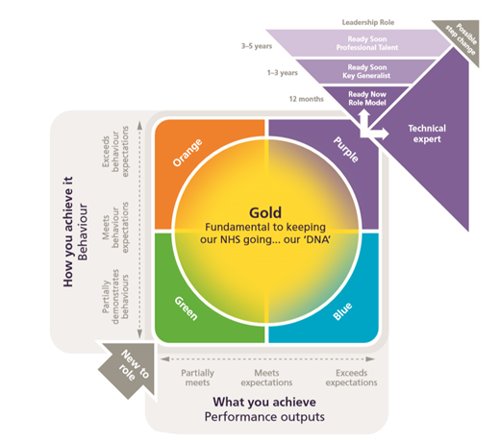
In a small, lean organisation like a GP practice, maximising the potential of every staff member is crucial. Here we look at how to spot, recruit, and develop talent, and how to use the Maximising Potential Conversation Tool.
Talent Management is a broad term that describes the recruitment and retention of the most valuable assets in any organisation, regardless of size—its staff. Hiring should never be a random, hit-and-hope event—it must be targeted and informed. Once staff are in an organisation, they cannot simply be left to their own devices in the hope that they’ll develop and eventually gravitate towards more senior roles. In order to really achieve the holy grail of ‘right person, right role’ they must be actively managed, and tools such as succession planning used to plan for the future.
One tool which is useful in the context of talent planning, whether you’re an ICS or a GP surgery, is known as the Maximising Potential Conversation Tool (MPCT). Although this is only the start of what should be a continuous process, it is a key part of supporting individuals and helping them to see the path ahead to development. In a small, lean organisation like a GP practice, maximising the potential and effectiveness of every staff member is particularly important.
Identifying their potential and guiding them to reaching it is not merely a box-ticking exercise, nor is it simply a ‘nice-to-have’. It’s a crucial part of staff wellbeing, and there is good evidence of its benefits. Staff supported in this way feel more energised, fulfilled, engaged, effective—and they perform better in their roles. The link between employee engagement and talent management is particularly strong. Engagement leads to pride, commitment, going the extra mile—all things which ultimately lead to better patient care. It also reduces the turnover rate, so time and money otherwise spent on recruiting is saved.
The MPCT is not simply designed for senior or operationally important roles; instead, it should consider all staff in an organisation. It should ask the questions which will allow progress to be charted and destinations to be revealed. In this way, people are seen as more than merely ‘employees’, but rather as rounded individuals with their own nuanced skillsets and potential. The Maximising Potential conversation should cover:
- What development the staff member requires
- What the value of this development is now, and what it will be in the future
- What skills best suit them now
- What skills will best suit them in the future (within that organisation or elsewhere)
Graphic: explaining the Maximising Potential Conversation Tool (MPCT)

Below are the basic steps that employer and employee should follow to plan for and have the conversation. Try to follow up regularly afterwards.
- Prepare: there are some useful materials from the NHS Leadership Academy that both managers and employees may find helpful when preparing. Gather evidence for what you will say in the meeting, and reflect on where your staff member’s real strengths lie. What are the goals and aspirations that the practice or organisation itself has? How do the employee’s goals match these? How can success be measured?
- Have the conversation: a guide to the MPCT can be used to help, including the 9x9 grid. Make sure you choose a location that’s quiet and comfortable, and allow enough time for the conversation. Agree broadly what you want the outcome of the conversation to be.
- Identify ways to enhance the individual’s potential: this includes in their current role and in potential future roles. Relevant opportunities for progression and development should be signposted. These may be from a variety of sources:
- Local trust opportunities (locally-led leadership programmes)
- Regional Leadership Academy opportunities
- National Leadership Academy opportunities (see leadershipacademy.nhs.uk )
- Follow-up after conversation: once you’ve completed the conversation, ensure that support is given to the employee around development, and monitor its impact. Evaluate the interventions that are made, and consider benchmarking ratings you give with other managers. Remember that the process should be continuous.
Talent management also leads to stability and success in periods of change and transformation. In a GP practice, especially following a global pandemic, change happens constantly. Therefore, the better the standard of talent management, the easier it will be for teams and processes to change, and change effectively.
You might feel reluctant to invest so much in someone you may end up saying goodbye to down the line, either within your organisation to another role elsewhere. But remember that you can stay in touch with that person who can then become a useful contact who can help your team from their new position. You also have the added satisfaction of knowing that you have helped that person progress and succeed professionally.
If you’re a line manager, your role is to spot talent, recruit it, manage it and develop it. Remember that the success of any people strategy depends to a large degree on how well, and to what extent, line managers implement the actions and plans. You can read more about how great line managers can help to nurture talent in this study.
Thornfields offers a range of training courses which can also help you with the issues raised in this article. These include Talent Management (new for 2022), Recruiting the Right Person, Total Teamworking, and Successful Business Manager in Primary Care.

0 Comments